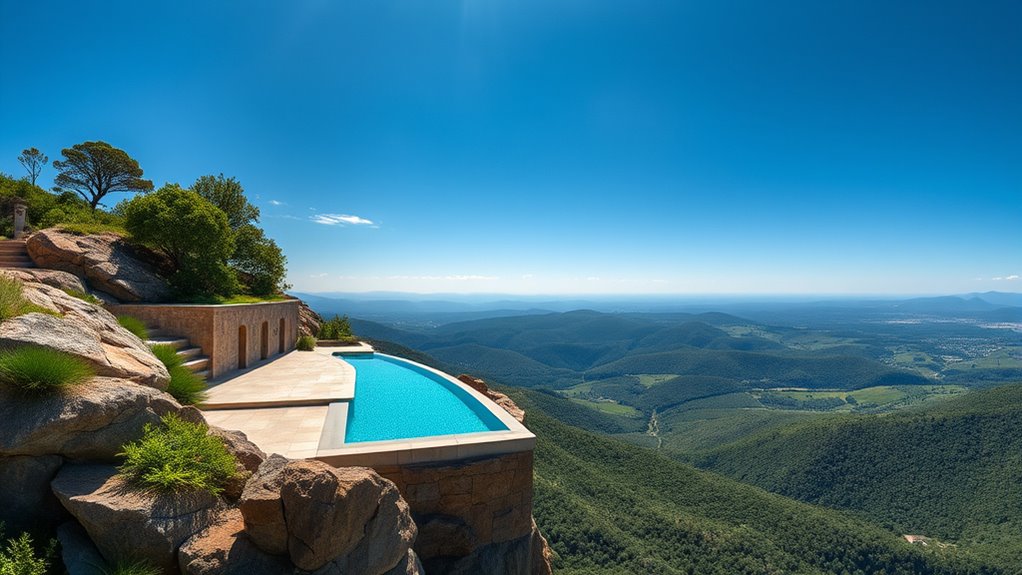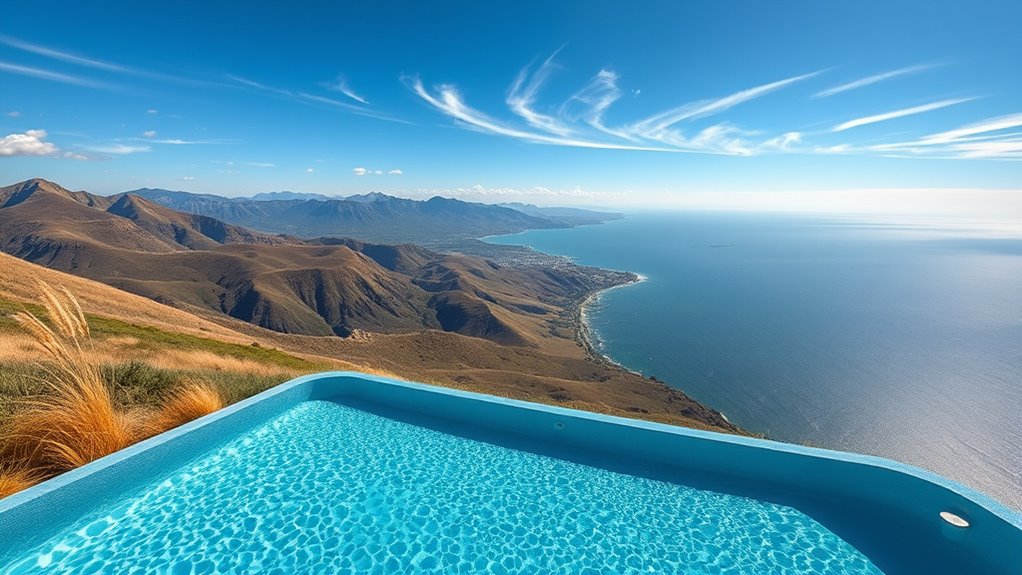To select the ideal site for your infinity pool, focus on a gently sloped terrain that allows for proper drainage and stability. Position the pool to maximize scenic views by choosing higher ground or natural land contours that overlook beautiful landscapes. Consider sunlight patterns to ensure comfort and energy efficiency, and check accessibility for construction. If you optimize slope and views now, you’ll create a stunning, safe, and enduring feature—learn more about balancing these factors effectively.
Key Takeaways
- Select a gently sloped site with a gradient of 10-15% to ensure proper water flow and minimal excavation.
- Position the pool to maximize scenic views, such as horizons, water bodies, or natural landscapes.
- Avoid obstructions like tall trees or structures that block sightlines and natural vistas.
- Incorporate natural terrain contours into the pool design for seamless integration and aesthetic appeal.
- Ensure the slope directs water runoff away from the pool area to prevent erosion and water pooling.
Understanding the Importance of Site Topography

Understanding the importance of site topography is essential because it directly impacts the safety, accessibility, and long-term viability of a project. Your landscape’s slope, elevation changes, and natural features influence how you approach construction and design. A flat, stable site offers easier installation and reduces foundation issues, while steep or uneven terrain can pose risks and increase costs. It also affects drainage and water runoff, which are critical for maintaining pool integrity and preventing erosion. By evaluating the topography early, you can identify potential challenges and opportunities, ensuring your project is both safe and sustainable. Recognizing these factors helps you make informed decisions about location and layout, ultimately contributing to a successful, long-lasting pool installation. Additionally, understanding environmental impacts can guide you in choosing a site that minimizes ecological disruption and promotes sustainability.
Assessing the Slope for Proper Pool Placement

Evaluating the slope of your site is a crucial step in ensuring proper pool placement. A gentle, consistent incline helps prevent water runoff and drainage issues. Too steep, and you’ll face stability challenges; too flat, and drainage problems may occur. To appraise your slope effectively:
- Use a level or laser tool to measure the incline across different points.
- Check for drainage patterns that could cause erosion or pooling.
- Identify areas with natural drainage or runoff tendencies.
- Keep in mind that proper slope assessment can significantly influence the longevity and safety of your infinity pool.
Understanding these factors helps you determine the best location for your infinity pool. Properly evaluating slope ensures stability, proper water management, and minimizes future landscaping work. Remember, slight variations in elevation can notably impact the pool’s longevity and performance. Accurate assessment sets the foundation for a successful installation.
Maximizing Scenic Vistas and Natural Beauty

To truly enhance your pool’s appeal, focus on positioning it to capture the most breathtaking views and natural surroundings. Choose a location that overlooks scenic landscapes, such as rolling hills, a lush forest, or a sparkling waterway. Elevate the pool to maximize visibility of these features and create a seamless connection between your outdoor space and nature. Keep obstacles like tall trees or structures in mind, as they can obstruct your view. Incorporate large glass barriers or open edges to bring the scenery into your line of sight. Additionally, considering the contrast ratio of your surroundings can help in selecting a site where the natural light enhances the visual experience. By thoughtfully selecting a site with stunning vistas, you’ll create a luxurious, immersive experience that feels like an extension of the landscape, elevating your backyard into a personal retreat.
Analyzing Sunlight and Shadow Patterns

Analyzing sunlight and shadow patterns is essential for optimizing your pool’s placement and comfort. By understanding how sunlight moves across your site, you can maximize warmth and minimize glare. Observe how shadows cast during different times of day and seasons to identify areas that stay shaded or receive ample sunlight. This helps you choose a spot that keeps your pool comfortable without excessive heat or cooling. Additionally, utilizing tools such as timing aids can assist in accurately predicting sunlight exposure throughout the year.
Orienting Your Pool for Optimal Views and Privacy

Have you considered how the orientation of your pool can enhance your view and privacy? Positioning your pool to face scenic vistas maximizes your enjoyment and creates a breathtaking backdrop. Turn it away from neighboring properties or busy streets to maintain privacy, preventing passersby from peering in. Think about natural barriers like trees, fences, or walls that can shield your space without obstructing your view. Also, consider the prevailing wind direction; orienting your pool to minimize wind exposure keeps the water calmer. By carefully selecting the pool’s orientation, you create a secluded, picturesque oasis that balances stunning views with personal privacy, embracing creative practice and making your backyard a true retreat.
Considering Accessibility and Construction Feasibility

When choosing a site, you need to take into account how stable the terrain is and how easily construction equipment can access the area. Steep slopes and uneven ground can complicate building plans and increase costs. Addressing these challenges early ensures your project stays on track and manageable. For example, evaluating the installation process of various conversion kits can provide insights into the ease of setup and potential modifications needed for your site.
Terrain Stability and Ease
Choosing a site with stable terrain is essential because it directly impacts both accessibility and construction ease. When the ground is solid and even, you’ll find it easier to build the pool and navigate the area. Unstable or uneven terrain can cause delays, additional costs, and safety concerns. To guarantee smooth progress, look for terrain that offers:
- Firm, compact soil that supports heavy equipment
- Minimal slope or natural flatness for straightforward construction
- Lack of loose rocks or loose soil prone to erosion
- Considering cost and budgeting factors can help you allocate resources efficiently during site development.
Construction Equipment Access
Making certain of easy access for construction equipment is crucial because it directly affects the project’s timeline and cost. If heavy machinery can’t reach the site efficiently, delays and extra expenses quickly add up. You need to evaluate the terrain for clear pathways and consider existing access points. Narrow or steep routes can hinder the delivery of materials and equipment, leading to setbacks. Planning for suitable access routes minimizes the risk of damage to the landscape and guarantees safety. Additionally, understanding the best juice cleanses for weight loss can help inform nutritional planning during construction phases that require dietary adjustments.
Slope Management Challenges
Managing slopes on a construction site can considerably impact both accessibility and overall feasibility. Steep or uneven terrain complicates movement, making it harder for workers and equipment to operate efficiently. You’ll need to address erosion control, soil stability, and drainage issues to prevent future problems. Failure to manage slopes properly can lead to delays, increased costs, and safety hazards. Incorporating soil stabilization methods can greatly enhance slope safety and durability.
Consider these challenges:
- Ensuring safe access pathways without compromising the site’s integrity
- Stabilizing soil to prevent landslides or erosion during and after construction
- Designing effective drainage systems to handle runoff and prevent pooling or undermining
Balancing aesthetic appeal with practical concerns requires careful planning and skilled execution to keep your project on track and safe.
Integrating the Pool Into the Existing Landscape

You should focus on blending the pool seamlessly with natural elements like trees and rocks to create a cohesive look. Preserving the landscape’s integrity means working with existing features rather than removing them. When you prioritize harmony, the pool enhances your yard without disrupting its original beauty. Incorporating landscape design principles can help achieve a balanced integration of the pool into your environment.
Harmonizing Natural Elements
Integrating a pool seamlessly into your existing landscape begins with understanding the natural features around your property. Pay attention to the terrain, existing vegetation, and water flow, as these elements influence how your pool will blend in. To create harmony, consider using native plants that complement the surrounding environment, avoiding invasive species that could disrupt the landscape. Incorporate natural materials like stone or wood to match the local aesthetic and soften the pool’s edges. Think about how the pool’s shape can mirror the natural contours of the land or water features nearby.
- Use native plants to enhance visual continuity
- Choose natural materials for a cohesive look
- Design the pool shape to echo landscape curves
Preserving Landscape Integrity
Preserving the integrity of your landscape involves careful planning to guarantee the new pool enhances rather than disrupts the existing environment. Start by evaluating your site’s natural features, such as trees, rock formations, and slopes, and aim to incorporate them into your design. Use materials and colors that blend seamlessly with the surroundings to maintain visual harmony. Consider the pool’s placement carefully—position it to minimize excavation and avoid removing mature plants or unique landscape elements. Incorporate native plants around the pool area to create a cohesive look and support local ecosystems. Keep pathways and access points unobtrusive, ensuring they don’t fragment the landscape. By respecting your land’s natural flow, you preserve its beauty while creating a stunning, integrated infinity pool.
Evaluating Local Climate and Wind Conditions

Understanding the local climate and wind conditions is essential for selecting an ideal site. These factors directly impact your pool’s longevity, safety, and comfort. High wind speeds can cause water evaporation and spray, leading to increased maintenance. Extreme temperatures may affect water temperature and your overall enjoyment. Humidity levels influence mold growth and structural integrity. To evaluate these conditions, consider:
- Typical wind speeds and prevailing directions
- Seasonal temperature fluctuations
- Humidity patterns and rainfall frequency
Consulting With Professionals for Site Analysis

Consulting with professionals for site analysis guarantees you get accurate, expert insights into your chosen location. They assess factors like slope stability, soil quality, drainage, and sun exposure, ensuring your site is suitable for an infinity pool. Professionals can identify potential issues early, saving you time and money. Their expertise helps determine the best placement for your pool to maximize views and privacy. They also consider local building codes, permits, and environmental regulations, guiding you through the approval process. By working with landscape architects, engineers, or experienced contractors, you gain tailored recommendations that align with your vision and site specifics. Ultimately, professional analysis assures your project is safe, sustainable, and perfectly suited to your landscape, making your pool installation smooth and successful.
Frequently Asked Questions
How Does Soil Stability Affect Infinity Pool Installation?
Soil stability is vital for your infinity pool installation. If the soil is unstable or weak, it can shift or settle, causing structural issues or cracks in your pool. You need solid, well-compacted soil to support the weight and pressure of the water. Proper soil testing and reinforcement help guarantee your pool remains safe and secure over time, preventing costly repairs and ensuring long-lasting enjoyment.
What Are the Local Building Codes for Pool Construction?
You need to check your local building codes before starting your pool project. For example, in California, you must adhere to the California Building Code, which covers safety barriers, electrical wiring, and drainage systems. These regulations guarantee safety and compliance. Visit your city or county’s building department website or contact them directly to get specific requirements. Failing to follow these codes can lead to fines or delays in your pool installation.
How Can I Minimize Environmental Impact During Site Prep?
You can minimize environmental impact during site prep by planning carefully to avoid disrupting local wildlife and vegetation. Use erosion control methods like silt fences, limit heavy machinery to designated areas, and preserve existing trees whenever possible. Opt for eco-friendly materials, and consider implementing runoff management systems. Communicate with local authorities and environmental experts to guarantee your site prep aligns with sustainability best practices, reducing your overall ecological footprint.
What Maintenance Considerations Are Unique to Hillside Pools?
Imagine your hillside pool constantly battling soil erosion; that’s a vital maintenance concern. You’ll need to regularly inspect and reinforce retaining walls, ensuring they hold back shifting earth. Drainage systems must be meticulously maintained to prevent water buildup that could destabilize the slope. Additionally, cleaning debris from surrounding vegetation is essential to avoid clogging filters. Properly addressing these issues keeps your hillside pool safe, beautiful, and functional long-term.
How Do Nearby Trees Influence Pool Temperature and Cleanliness?
Nearby trees can considerably impact your pool’s temperature and cleanliness. Falling leaves and debris can dirty the water, increasing your maintenance efforts. They also provide shade, which might lower the water temperature, making swimming less appealing during hotter months. Additionally, trees may release pollen or sap, further contaminating your pool. Regular skimming, filtering, and balancing chemicals become essential to keep your pool inviting and clean amidst nearby trees.
Conclusion
Choosing the perfect site for your infinity pool isn’t just about the view or slope—you’re shaping a sanctuary that transforms your space. Every detail, from sunlight to landscape, influences your experience. But the true magic lies in revealing what’s hidden beneath the surface, waiting to be discovered. Are you ready to open the potential of your landscape and create a breathtaking oasis that’s uniquely yours? The next step could change everything.










